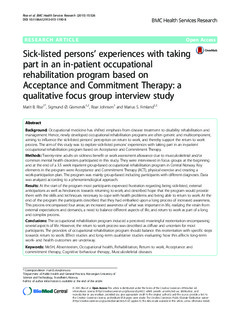| dc.contributor.author | Rise, Marit By | |
| dc.contributor.author | Gismervik, Sigmund Østgård | |
| dc.contributor.author | Johnsen, Roar | |
| dc.contributor.author | Fimland, Marius Steiro | |
| dc.date.accessioned | 2015-11-29T13:37:37Z | |
| dc.date.accessioned | 2015-12-01T10:10:36Z | |
| dc.date.available | 2015-11-29T13:37:37Z | |
| dc.date.available | 2015-12-01T10:10:36Z | |
| dc.date.issued | 2015 | |
| dc.identifier.citation | BMC Health Services Research 2015, 526 | nb_NO |
| dc.identifier.issn | 1472-6963 | |
| dc.identifier.uri | http://hdl.handle.net/11250/2366373 | |
| dc.description.abstract | Background: Occupational medicine has shifted emphasis from disease treatment to disability rehabilitation and
management. Hence, newly developed occupational rehabilitation programs are often generic and multicomponent,
aiming to influence the sick-listed persons’ perception on return to work, and thereby support the return to work
process. The aim of this study was to explore sick-listed persons’ experiences with taking part in an in-patient
occupational rehabilitation program based on Acceptance and Commitment Therapy.
Methods: Twenty-nine adults on sickness benefit or work assessment allowance due to musculoskeletal and/or
common mental health disorders participated in this study. They were interviewed in focus groups at the beginning
and at the end of a 3.5 week inpatient group-based occupational rehabilitation program in Central Norway. Key
elements in the program were Acceptance and Commitment Therapy (ACT), physical exercise and creating a
work-participation plan. The program was mainly group-based including participants with different diagnoses. Data
was analyzed according to a phenomenological approach.
Results: At the start of the program most participants expressed frustration regarding being sick-listed, external
anticipations as well as hindrances towards returning to work, and described hope that the program would provide
them with the skills and techniques necessary to cope with health problems and being able to return to work. At the
end of the program the participants described that they had embarked upon a long process of increased awareness.
This process encompassed four areas; an increased awareness of what was important in life, realizing the strain from
external expectations and demands, a need to balance different aspects of life, and return to work as part of a long
and complex process.
Conclusions: The occupational rehabilitation program induced a perceived meaningful reorientation encompassing
several aspects of life. However, the return to work process was described as diffuse and uncertain for most
participants. The providers of occupational rehabilitation program should balance this reorientation with specific steps
towards return to work. Effect studies and long-term qualitative studies evaluating how this affects long-term
work- and health outcomes are underway.
Keywords: MeSH, Absenteeism, Occupational health, Rehabilitation, Return to work, Acceptance and
commitment therapy, Cognitive behaviour therapy, Musculoskeletal diseases. | nb_NO |
| dc.language.iso | eng | nb_NO |
| dc.publisher | BioMed Central | nb_NO |
| dc.title | Sick-listed persons’ experiences with taking part in an in-patient occupational rehabilitation program based on Acceptance and Commitment Therapy: a qualitative focus group interview study | nb_NO |
| dc.type | Journal article | nb_NO |
| dc.type | Peer reviewed | en_GB |
| dc.date.updated | 2015-11-29T13:37:37Z | |
| dc.source.volume | 526 | nb_NO |
| dc.source.journal | BMC Health Services Research | nb_NO |
| dc.identifier.doi | 10.1186/s12913-015-1190-8 | |
| dc.identifier.cristin | 1294732 | |
| dc.description.localcode | © 2015 Rise et al. Open AccessThis article is distributed under the terms of the Creative Commons Attribution 4.0 International License (http://creativecommons.org/licenses/by/4.0/), which permits unrestricted use, distribution, and reproduction in any medium, provided you give appropriate credit to the original author(s) and the source, provide a link to the Creative Commons license, and indicate if changes were made. The Creative Commons Public Domain Dedication waiver (http://creativecommons.org/publicdomain/zero/1.0/) applies to the data made available in this article, unless otherwise stated. | nb_NO |
